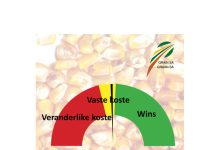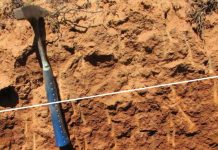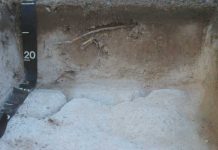



Scientific name: Emex australis
Afrikaans name: Kaapse dubbeltjie
English name: Spiny Emex, Three-cornered Jack, Devil’s thorn
Short description
Decumbent to semi-erect annual plants, up to 60 cm high when growing densely. Leaves and stems appear vivid green from seedling stage. Leaves are simple, alternately arranged or arranged in small bundles, egg-shaped (ovoid) to oblong, up to 8 cm long and 5 cm wide.
Flowers are green, in axillary bundles, but not very prominent. Fruits are big, triangular and clearly visible on the plant between the leaves. It has three indentations on each side and three strong, sharp, spreading thorns that can cause a lot of discomfort for humans and animals. Seeds are produced all year round.
Distribution
Spiny Emex is widespread in southern Africa and can be a problem weed in both winter and summer rainfall areas. It is rapidly distributing to dry land maize and can be a problem where wheat is being irrigated.
Control
Chemically
Various pre- and post-emergence herbicides are registered for the control of Spiny Emex in maize and wheat (Table 1 and Table 2). Pre-emergence herbicides are administered in the soil during planting or within four days after planting. Sufficient soil moisture is necessary to activate pre-emergence herbicides in the soil and to provide effective control. Post-emergence herbicides are administered after emergence of the weed and/or crop.
Follow the specific instructions and prescriptions on the label of each product. For effective control post-emergence herbicides should preferably be mixed with an additive that promotes the penetration of the herbicide. See label for instructions.
Spiny Emex can be a tough weed and should be controlled as soon as possible post-emergence. The optimum time is between two to six leaf stages of the weed. The bigger the plant, the less effective the herbicide will be.
Although this weed is not an important weed in wheat production of the Free State, it is distributed freely in the Western Cape production areas. Because resistance to herbicides has not yet been reported for this weed, broad leaf herbicides are still used with success. Always take into consideration resistance and do not use herbicides against which there already are resistance. Always contact a reliable chemical advisor before using any chemicals to ensure the correct dose and specifications on the label are adhered to.
TABLE 1: Herbicides registered to control Spiny Emex in maize.
| Active ingredient | Formula | Time of application |
|---|---|---|
| atrazine/sulcotrione | 300/125 g/litre | Pre-emergence or early post-emergence of the weed |
| bromoxynil | 225 g/litre 400 g/litre 450 g/litre 500 g/litre | Post-emergence of weed between four or six leaf growth stage |
| dicamba/topramezone | 160/50 g/litre | Early post-emergence before six leaf stage. Apply in tank mixture with atrazine or atrazine/terbuthylazine |
| flumetsulam | 800 g/kg | Pre-emergence apply in tank mixture with metolachlor or s-metolachlor |
| linuron | 500 g/litre | Pre-emergence or only directed post-emergence application between row crops when weed is 35 to 50 cm tall |
| metribuzin | 480 g/litre | Post-emergence between the four to six leaf stage of the weed |
| topramezone | 336 g/litre | Early post-emergence before six leaf stage. Apply in tank mixture with atrazine or atrazine/terbuthylazine |
TABLE 2: Herbicides registered to control Spiny Emex in wheat.
| Active ingredient | Formula | Time of application |
|---|---|---|
| 2,4-D/dicamba | 240/80 g/litre | Post-emergence between two to six leaf growth stage |
| bromoxynil | 225 g/litre 400 g/litre 450 g/litre 500 g/litre | Post-emergence, weed fully emerged, but not older than three leaf stage |
| bromoxynil/pyrasulfotole | 210/37,5 g/litre | Post-emergence, weeds fully germinated and between four to six leaf stage |
| carfentrazone-ethyl/metsulfuron-methyl | 400/100 g/kg | Post-emergence, when weed is between two to six leaf stage |
| carfentrazone-ethyl | 400 g/kg | Post-emergence, when weed is between two to six leaf stage |
| chloorsulfuroon | 750 g/kg | Post-emergence, when weed is between two to six leaf stage |
| chlorsulfuron/metsulfuron-methyl/tribenuron-methyl | 119/79/222 g/kg | Post emergence of weed, when crop is between four to six leaf stage |
| florasulam/flumetsulam | 75/100 g/litre | Post emergence of weed, between four to six leaf growth stage |
| iodosulfuron-methyl sodium/mefenpyr-diethyl | 50/150 g/kg | Post-emergence, weed fully germinated. Apply when crop is between growth stages seven and thirteen |
| iodosulfuron-methyl sodium/metsulfuron-methyl/mefenpyr-diethyl | 30/30/90 g/kg | Post-emergence, weed fully germinated and when the crop reached four leaf stage |
| metsulfuron-methyl/thifensulfuron-methyl | 68/680 g/kg | Post-emergence, when weed is between four to five leaf stages |
| metsulfuron-methyl/tribenuron-methyl | 80/300 g/kg | Post-emergence, when weed is between two to six leaf stages |
| metsulfuron-methyl | 200 g/kg 500 g/kg 600 g/kg | Post-emergence, apply when crop is in the three to five leaf stage Post-emergence, when weed is between two to six leaf stages and crop between three to five leaf stages |
| prosulfocarb | 800 g/litre | Pre-emergence, apply in tank mixture with trifluralin en triasulfuron |
| prosulfuron | 750 g/kg | Post-emergence when weed is between two to six leaf stages |
| pyroxsulam | 45 g/liter | Post-emergence when weed is between two to six leaf stages |
| sulfosulfuron | 750 g/kg | Post-emergence when weed is between one to four leaf stages |
| thifensulfuron-methyl | 750 g/kg | Post-emergence, when weed is between four to five leaf stages |
| triasulfuron | 750 g/kg | Pre-emergence applied during planting |
Cultivation
Shallow cultivation can lessen the amount of Spiny Emex.
Contact the writers at elbe.hugo@syngenta.com (Elbe Hugo) and deweth@arc.agric.za (Hestia Nienaber).

















